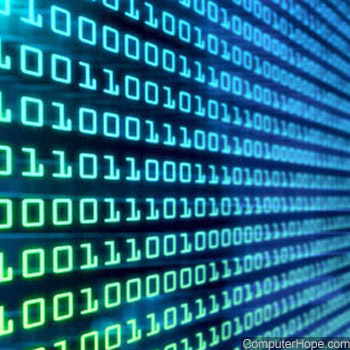Data

In general, data is any set of characters that is gathered and translated for some purpose, usually analysis. If data is not put into context, it doesn't do anything to a human or computer.
Data is identified by and processed according to its data type. There are multiple types of data. Some more common types of data include the following:
- Single character
- Boolean (true or false)
- Text (string)
- Number (integer or floating-point)
- Picture
- Sound
- Video
In a computer's storage, digital data is a sequence of bits (binary digits) with a value of one or zero. Data is processed by the CPU (Central Processing Unit), which uses logical operations to produce new data (output) from source data (input).
Examples of computer data
Joe,Smith, 1234 Circle,SLC,UT,8404,8015553211
0143 0157 0155 0160 0165 0164 0145 0162 0040 0150 0157 0160 0145
01100011011011110110110101110000011101010111010001100101011100100010000001101000000101
Who creates data?
Data can be created on a computer by the user, software, or hardware connected to the computer. In the case of a user, data is inputted using an input device such as a keyboard. With software, a program can create data from users interacting with the program or from another input source (e.g., a triggered alert). Finally, hardware can also create data from an alert received by a sensor or other input.
How is data stored on a computer?
Electronic data and information are stored as binary, most commonly on a hard drive inside the computer. However, data may also be stored on any other storage device.
How data moves in a computer
How data moves on a computer depends on where it's traveling. Data travels over a bus when going between devices on the motherboard, like between the CPU (Central Processing Unit) and RAM (Random-Access Memory). Data transfers between a computer and a device travel over a data cable. For example, the data cable might be an HDMI (High-Definition Multimedia Interface) cable to transfer a data signal to a display device.
See our data cable page for other examples of data cables used with computers.
Mobile data
With smartphones and other mobile devices, data describes any data transmitted over the Internet wirelessly by the device. See our data plan definition for further information.
Grammatical usage
Data is a plural noun, as in, "The data are being processed." The singular form of data is datum, from the Latin word meaning "something given."
While using data as a plural noun is technically correct, in modern usage, data is also accepted as a singular noun, as in, "The data is being processed."
How do you pronounce data?
The pronunciation of "data" can vary depending on the part of the world of the person speaking the word. Globally, it's pronounced as day-ta, dat-ta, dah-ta, or dar-ta. In America, it's usually pronounced as both day-ta and dat-ta.
Because data pronunciation is regionally different, all earlier pronunciations are considered correct. However, we recommend using the pronunciation used in your area of residence.
Artificial intelligence terms, Calibration, Computer Instructions, Dat, Data+, Data acquisition, Database terms, Data loss, Data manipulation, Data mining, Data processing, Data recovery, Data set, Information, Massage, Raw data, Sanitized data, Software terms, Source data, Spreadsheet terms
